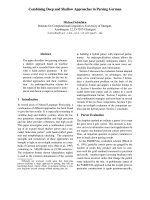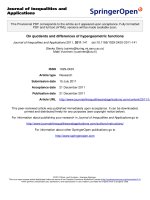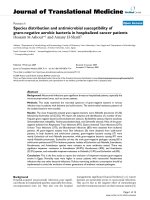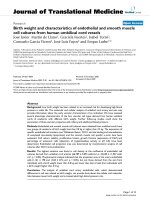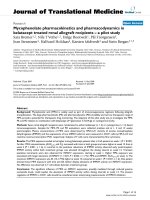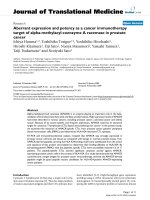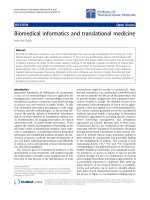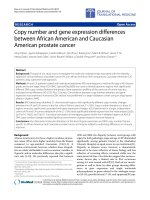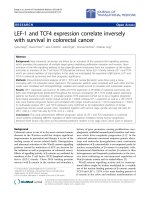Báo cáo hóa học: " Gait stability and variability measures show effects of impaired cognition and dual tasking in frail people" pptx
Bạn đang xem bản rút gọn của tài liệu. Xem và tải ngay bản đầy đủ của tài liệu tại đây (587.72 KB, 9 trang )
RESEARCH Open Access
Gait stability and variability measures show
effects of impaired cognition and dual tasking
in frail people
Claudine J Lamoth
1*
, Floor J van Deudekom
2
, Jos P van Campen
2
, Bregje A Appels
3
, Oscar J de Vries
4
,
Mirjam Pijnappels
5
Abstract
Background: Falls in frail elderly are a common problem with a rising incidence. Gait and postural instability are
major risk factors for falling, particularly in geriatric patients. As walking requires attention, cognitive impairments
are likely to contribute to an increased fall risk. An objective quantification of gait and balance ability is required to
identify persons with a high tendency to fall. Recent studies have shown that stride variability is increased in
elderly and under dual task condition and might be more sensitive to detect fall risk than walking speed. In the
present study we complemented stride related measures with measures that quantify trunk movement patterns as
indicators of dynamic balance ability during walking. The aim of the study was to quantify the effect of impaired
cognition and dual tasking on gait variability and stability in geriatric patients.
Methods: Thirteen elderly with dementia (mean age: 82.6 ± 4.3 years) and thirteen without dementia (79.4 ± 5.55)
recruited from a geriatric day clinic, walked at self- selected speed with and without performing a verbal dual task.
The Mini Mental State Examination and the Seven Minute Screen were administered. Trunk accelerations were
measured with an accelerometer. In addition to walking speed, mean, and variability of stride times, gait stability
was quantified using stochastic dynamical measures, namely regularity (sample entropy, long range correlations)
and local stability exponents of trunk accelerations.
Results: Dual tasking significantly (p < 0.05) decreased walking speed, while stride time variability increased, and
stability and regularity of lateral trunk accelerations decreased. Cognitively impaired elderly showed significantly (p
< 0.05) more changes in gait variability than cognitive intact elderly. Differences in dynamic parameters between
groups were more discerned under dual task conditions.
Conclusions: The observed trunk adaptations were a consistent instability factor. These results support the concept
that changes in cognitive functions contribute to changes in the variability and stability of the gait pattern.
Walking under dual task conditions and quantifying gait using dynamical parameters can improve detecting
walking disorders and might help to identify those elderly who are able to adapt walking ability and those who
are not and thus are at greater risk for falling.
Background
One in three community-dwelling persons over 65 years
of age falls at least once a year and this rate increases
rapidly with age, and frailty [1]. Gait and balance disor-
ders are suggested to better predict imminent falls than
risk factors in o ther domains such as impaired vision
and medication [1,2]. Therefore, the objective quantifi-
cation of ga it and balance disorders to detect persons
who have high risk of falls is of utmost importance,
especially in geriatric patients with cognitive decline
who have a high tendency to fall.
Age-associ ated chang es in gait characteristics, such as
lower walking speed, reduced step length and increased
step time have been interpreted as a more cautious,
* Correspondence:
1
Center for Human Movement Sciences, University Medical Centre
Groningen, University of Groningen, the Netherlands
Full list of author information is available at the end of the article
Lamoth et al. Journal of NeuroEngineering and Rehabilitation 2011, 8:2
/>JNER
JOURNAL OF NEUROENGINEERING
AND REHABILITATION
© 2011 Lamoth et al; licensee BioMed Central Ltd. This is an Open Access article d istributed under the terms of the Creative Commons
Attribution Licens e ( which permits unrestricted use, distribution, and reproduction in
any medium, provided the original work is properly cited.
conservative gait pattern adopted to increase gait stabi-
lity and decrease fall risk [3,4]. A more conscious gait
pattern, however, may require more cognitive control
and result in an attention demanding form of locomo-
tion. If walking requires more cognitive control and
becomes less automated, it might be more prone to be
influenced by concurrent (cognitive) dual tasks. Even in
healthy persons, dual tasks have been shown to affect
walking performance [5,6]. With aging or pathologic
conditions, gait changes in response to dual tasking
might have a destabilizing effect on the gait pattern
[7-9].
There is growing evidence that executive functions,
plays an important role in the ability to perform a
motor and cognitive task simultaneously in elderly
[10-12]. Particularly in frail elderly and in persons with
Alzheimer’s disease, performance of a cognitive task
during a motor task is reported to be associated with
changes in gait stability and increased fall risk
[10,13,14]. Stability is a significant component of stand-
ing balance and walking. A relatively new approach to
quantify gait and balance stability is by means of time
dependent analyses of variability using measures derived
from the theory of stochastic dynamics [13,15-17]. In
contrast to more conventional measures, (e.g. mean
stride time, walking velocity), which in the case of cyclic
movements treat each cycle as being an independent
event unrelated to previous or subsequent strides, the
applied methods assess fluctuations throughout the gait
cycle, and as such provide insight into how behaviour
unfolds, taking into account previous s tates of the sys-
tem (e.g., c ycle trajectory). Applying more traditional
measures may mask the temporal variations of the gait
pattern due to averaging procedures. A variety of
dynamic measures has been used to quant ify these time
dependent variations in gait patterns, including
Detrended Fluctuations Analysis [17], Sample Entropy
[18], and Lyapunov exponents [19]. Although concep-
tually different, these measures assume that walking
ability is reflected in dynamic characteristics, in terms of
variability in, or local stability of gait patterns. The out-
come variables obtained from studies using these meth-
ods, have proven to be sensit ive to differe nces between
various patient groups and between conditions and are
suggested to be related to increased fall risk [4,9,19-22].
Hence, these dynamic parameters may have more power
to differentiate between groups and to screen for high
risk fallers, particularly in frail elderly whose fall risk
might be enhanced by a cognitive impairment. We com-
plemented the stride related measures with measures
that quantify time varying patterns of trunk movements
during walking and that are closely related to dynamic
balance control during walking and standing. The aim
of the present study was to examine gait stability and
variability of geriatric patients with and without cogni-
tive impairment under normal and dual task walking
conditions. Based on previous studies, showing increased
stride-to-stride variability during dual tasking and in
elderly [4,14,22,23], and in line with the theoretical con-
cept t hat health is characterized by ‘organized’ variabil-
ity, while disease is defined by changes in the structure
of variability [24], we hypothesized that dual tasking
induced changes in the structure of the variability and
decreased local stability of trunk acceleration patterns.
Moreover, we anticipated that frail elderly patients with
cognitive impairment would be more affected in their
capacity to divide attention between a cognitive and a
motor task simultaneously, resulting in less stable and
more variable gait coordination than cognitive intact
frail elderly patients.
Methods
Participants
Twenty six elderly were recruited on the geriatric day
clinic of the hospital Slotervaart in Amsterdam. See
Table 1 for the population characteristics. Subjects were
included if they were 70 years of age or older and able
to walk inside without an assistive device. Participants
with a mobility impairment based on neurological or
orthopaedic disorders limiting one or both legs were
excluded as wel l as participants who did not understand
the instructions. The IADL (Instrumental Activities of
Daily living [25] was administered to assess dependency
in daily life and the CCI (Charlson Comorbidity Index)
[26] was determined to index the presence of co-mor-
bidity in this geriatric group of patients. In all partici-
pants, the Mini Mental State Examination (MMSE) [27]
and the Seven Minute Screen (SMS) [28] were adminis-
tered. Participants were divided into two groups, one
group suffering from cognitive impairment (MMSE < 23
and with a clinical diagnosis of Alzheimer’ s disease
according to the criteria of the Alzheimer’s Association ,
N = 13) and one group of cognitively unimpaired elderly
(MMSE > 26; N = 13) [29]. Both groups differed signifi-
cantly with respect to SMS scores with exception of the
clock drawing subtest, and the IADL score, and not
with respect to the CCI index (Table 1). The study was
approved by the Medical Ethical Committee of the Slo-
tervaart Hospital. Written informed consent was
obtained from the participant and/or the caretaker (or
legal attorney).
Procedure
Participants walked for 3 minutes (about 160 m) in a
well-lit, empty 40 m long corridor at self-selected speed.
Walking was performed once without and once while
performing a verbal dual task. In the dual task condi-
tion, participants were asked to perform a letter fluency
Lamoth et al. Journal of NeuroEngineering and Rehabilitation 2011, 8:2
/>Page 2 of 9
task in which the subject had to name as many words
starting with a predefined letter “ R” or “ G” [30]. This
task relies on set-shifting and speed of processing which
is considered an executive function. During walking
with the dual task, participants were instructed not to
prioritize either one of the tasks. Participa nts performed
the task also seated during three minutes. The number
of different words was counted.
During walking trials, trunk accelerations in 3
orthogonal directions were measured with a tri-axial
ambulant accelerometer (64×64×13 mm; DynaPort
®
MiniMo d, McRoberts BV, The Hague, the Netherlands),
fixed with an elastic belt at the level of third lumbar
spine segment close to the centre of mass [31]. S ample
frequency was 100 Hz.
Data analysis
Anterior-posterior and medio-lateral acceleration time
series were analyzed. All time series were corrected for
horizontal tilt and low pass filtered with a 3
th
order But-
terworth filter with a cut-off frequency of 20 Hz. From
the anterior-posterior acceleration signal, time indices of
left and right foot contacts were determined. From these
foot contact moments stride times were calculated by
subtracting subsequent foot contact times of the same
foot. For all participants and conditions, at least 150
successive strides (leaving start and end step s out) were
included in all analyses, however bends in the circuit,
were removed from the data using a median filter [32]
For each participant and condition, walking speed,
mean and coefficient of variation (CV) of stride times
were calculated. Stride frequency was defined as the
inverse of the mean left and right stride time intervals.
Phase variability index (PVI) was calculated, based on
the mean and variability of relative phases between con-
secutive contralateral footcontacts[33].LowerPVI
values represent more consistent timing and gait
symmetry.
For medio-lateral and anterior-posterior trunk accel-
erations, the magnitudes of the time series were calcu-
lated as the root mean squares (RMS) and peak
accelerations within strides were determined. In addi-
tion, time dependent variations of stride variables and
trunk acceleration patter ns were calculated. Specifically,
the structure of stride variability (stride-to-stride varia-
bility) and trunk accelerations patterns were assessed as
indicators of dynamic b alance ability during walking,
using the scaling exponent a (DFA) [34], the local stabi-
lity exponent (LSE)[35] and the sample entropy (SEn)
[18], which are briefly described below. For a mathema-
tical explanation see the associated references and for
applications see references [16,36].
Perturbations o f stability do not inevitably only come
from outside, even during unimpeded walking, ‘ small
scale’ perturbations created by neuromuscular noise [37]
continuously perturb the locomotor system. These per-
turbations may manifest themselves as the natural varia-
tions exhibited during walking, for instance i n the
stride-to-stride variability or in terms of changes in so-
called local stability. Whereas the standard deviation or
coefficient of variation of stride times provide informa-
tion about the magnitude of stride variability, the extent
to which stride interval time series exhibit ed long range
correlations (i.e. similar patterns of variation across mul-
tiple time s cales) is q uantified by the a of Detrended
Fluctuations Analysis (DFA). Before applying DFA,
Table 1 Population characteristics, cognitive and activity of daily living test scores
whole group cognitive intact cognitive impaired group differences*
N = 26 N = 13 N = 13 z-value p-value
Men/women (n) 10/16 6/7 4/9
Age (y) 81.00 ± 5.13 79.38 ± 5.55 82.62 ± 4.29 1.31 0.19
Length (cm) 165.17 ± 9.10 166.00 ± 8.05 164.35 ± 11.75 0.59 0.55
Weight (kg) 67.52 ± 12.90 72.59 ± 11.97 62.45 ± 12.16 2.18 0.03
MMSE 23.12 ± 5.81 28.23 ± 1.09 18.00 ± 3.54 4.36 < 0.001
SMS 61.74 ± 109.73 -2.13 ± 15.91 125.62 ±125.81 3.82 < 0.001
BTO 17.65 ± 31.04 1.00 ± 3.61 34.31 ± 37.32 3.45 0.001
ECR 9.73 ± 9.73 12.62 ± 3.15 6.85 ± 4.41 3.11 0.002
CD 9.00 ± 3.43 10.00 ± 2.35 8.01 ± 4.10 1.17 0.243
VF 10.19 ± 3.95 12.54 ± 3.02 7.85 ± 3.39 3.40 < 0.001
IADL 4.69 ± 5.04 7.54 ± 5.29 1.85 ± 2.73 2.89 0.003
CCI 2.00 ± 1.26 2.15 ± 1.34 1.85 ± 1.23 0.62 0.58
Values are mean ± standard deviations. Statistical differences between the cognitive intact and cognitive impaired participants are indicated by z- and p-values
(based on Mann-Whitney test). Abbreviations: MMSE = Minimal Mental Scale examination; Range: 0-30, scores < 23 indicating cognitive impairment. SMS = Seven
Minute Screening test, higher values indicate cognitive impairment, low or negative values the absence of cogni tive impairment. BTO = The Benton Temporal
Orientation; Range: 0 = intact orientation 113 = severe disorientation; ECR = Enhanced Cued Recall, Range: 0-16; CD = Clock drawing, maximum score = 14;VF=
Verbal Fluency task, range: 0-45.; IADL = Instrumental Activities of Daily living, maximal dependency = score of 14; CCI = Charlson Comorbidity Index.
Lamoth et al. Journal of NeuroEngineering and Rehabilitation 2011, 8:2
/>Page 3 of 9
outliers in the stride time data, caused by the turns in
the circuit, were removed from the data using a median
filter [32]. If the outcome variable a is between 0.5 and 1,
this indicates the presence of long range correlations in
the time series, i.e. future fluctuations are better pre-
dicted by past fluctuation and accordingly indicate a
stable more structured pattern if a get near 1. For uncor-
related time-series (e.g. white noise) a = 0.5. When 0 < a
< 0.5 a different type of power-law correlation exist such
that large and small values of the time-series are likely to
alternate. When a increases above 1 to 1.5, behaviour is
no longer determined by power law. DFA was applied to
stride time, as well as to medio-lateral and anterior-
posterior trunk accelerations.
The ability to resist perturbations was assessed by
means of maximum finite time lyapunov exponents or
so called local stability exponents (LSE) [35]. The size of
the LSE quantifies the average rate of divergence of
initially nearby trajectories in state space over a specified
finite time interval. In a stable system, nearby trajec-
tories will converge with time, whereas in an unstable
system initially nearby trajectories will diverge with time
[35].WhenaLSEisnegative,anyperturbationinthe
gait pattern will exponentially damp out and initially
nearby trajectories remain close. In contrast, for larger
LSE values, nearby points diverge as time evolves and
produce instability. The time delay estimated was 10%
of the gait cycle for all reconstructed state spaces. Fol-
lowing previous studies, an embedding dimension of 5
was chosen, since this has been proven to be appropri-
ate for kinematic gait data. Δt=1-3strides.Asaverage
stride times were different for participants walking with
different speeds, the time axes for the LSE curves of
trunk acceleration were rescaled per trial by multiplying
by the average stride frequency [38].
The degree of predictability or repeatable pattern fea-
tures in acceleration time series was indexed by means
of the SEn [18]. A periodic time series is completely
predictable and will have a SEn of zero. SEn is defined
as the negative natural logarithm of an estimate of the
conditional probability of epochs of length m (in this
study m = 5) that match point-wise within a tolerance r
and repeats itself for m+1 points. Small SEn values are
associated with great regularity while large SEn values
represent a small chance of simila r data being repeated .
The data were first normalized to unit variance, render-
ing the outcome scale-independent. Software available at
PhysioNet was used to calculate SEn[39].
Statistical analysis
Statistical analysis w as performed using SPSS version
14.0. Level of significance was set at p < 0.05. Non-para-
metric statistics was applied since normality assump-
tions were not met for most of the outcome variables.
Gro up effect and main condition effe cts were tested for
significance using the Mann-Whitney test and Wilcoxon
signed rank test. To examine the relation between SMS,
MMSE scores and gait and trunk variables, Spearman
correlations were calculated.
Results
Condition effects
The number of enumerating words did not differ signifi-
cantly (z = 0.12; p = 0.91) between dual (walking; 15.6 ±
4.5) and single task (sitting; 16.0 ± 8.3).
Walking speed and stride frequency decreased signifi-
cantly under the dual task condition, while stride-to-
stride variability increased (a decreased), mean stride
time, CV of stride times, and the PVI increased signifi-
cantly (Table 2).
During dual tasking, the RMS and peak values of ante-
rior-posterior and medio-lateral trunk accelerations, as
well as stride-to-stride variability (a) were significantly
lower (all p < 0.001) compared to normal walking,
whereas the LSE in an teri or-posterior and medio-lateral
trunk accelerations were significantly (p <0.001)
increased, indicating decreased stability (Figure 1). Dual
tasking further significantly decreased the regularity as
indicated by a larger SEn of anterior-posterior trunk
accelerations (p = 0.03) but not of medio-lateral
accelerations.
Group effect
No significant difference in the number of enumerating
words during walking was found between cognitively
intact and cognitively impaired elderly (14.4 ± 1.2 vs.
16.8 ± 1.4, respectively; p = 0.19), indicating that all
participants could perform the task.
For walking without dual tasking, no significant group
differences were found for any of the gait or trunk
Table 2 Effect of dual tasking on gait variables
Variables Walking Dual
Tasking
z-
value
p
speed (m/sec) 0.92 ± 0.24 0.80 ± 0.21 4.31 <
0.001
stride frequency (strides/
sec)
0.82 ± 0.11 0.77 ± 0.11 3.95 <
0.001
mean stride time (sec) 1.23 ± 0.18 1.33 ± 0.17 3.87 <
0.001
CV stride time (%) 3.61 ± 2.30 4.41 ± 2.34 2.83 0.005
PVI (%) 15.08 ±
7.60
17.68 ± 8.49 3.54 <
0.001
a stride times 0.85 ± 0.14 0.77 ± 0.15 2.48 0.013
Values during walking and dual tasking for: walking speed, stride frequency,
mean and coefficient of variation (CV) of stride times, the phase variability
index (PVI) and stride-t o-stride variability (a). Values are mean ± standard
deviations. Statistical differences between conditions are indicated by z- and
p-values (based on Wilcoxon signed rank test).
Lamoth et al. Journal of NeuroEngineering and Rehabilitation 2011, 8:2
/>Page 4 of 9
variables. However, when walking while performing a
dual task, significant differences were observed for the
RMS of t he medio-lateral trunk accelerations (z = 1.97,
p = 0.04), the structure of variability (a) of the medio-
lateral trunk accelerations (z = 2.64, p =0.008),andfor
trunk anterior-posterior peak accelerations (z = 1.92, p
= 0.05). Lower values of a for medio-lateral trunk accel-
erations in the cognitive impaired elderly indicated a
less correlated (more random) trunk acceleration pattern
than in the cognitive intact group. In addition, signifi-
cant group effects were observed for PVI (z = -2.18, p =
0.03) and stride-to-stride variability (z = -2.13, p = 0.03),
both implying an increased variability of gait t iming in
the cognitive impaired elderly (Figure 2). In contrast,
walking velocity and mean and CV of stride times were
not significantly different between groups (Table 3).
Overall, corre lations between MMSE, SMS scores,
and stride and trunk acceleration measures were low (r <
0.3). Within the cognitive impaired group, the associa-
tions were hig her for several gait measures (see Table 4).
Of the SMS tests, the temporal orientation and verbal
fluency subtests correlated moderately to high (range
0.5-0.7) with the gait variables, whereas no association
Figure 1 Effect of dual tasking. Boxplots of significant (all p < 0.05) effects of dual t asking on medio-lateral (ML) and anterior-posterior (AP)
trunk accelerations patterns. The lower and upper lines of the box are the 25th and 75th percentiles of the sample. The line in the middle of
the box is the sample median. The vertical lines extending above and below the box show the extent of the rest of the sample.
Figure 2 Group differenc es. Boxplots of significant (all p < 0.05)
differences between the cognitive impaired and cognitive intact
elderly on trunk variability of ML trunk acceleration patterns as
quantified by the RMS and the a and of stride-to-stride variability
quantified by the phase variability index (PVI) and the a of the stride-
to-stride fluctuations. The lower and upper lines of the box are the
25th and 75th percentiles of the sample. The line in the middle of the
box is the sample median. The vertical lines extending above and
below the box show the extent of the rest of the data.
Lamoth et al. Journal of NeuroEngineering and Rehabilitation 2011, 8:2
/>Page 5 of 9
was found for the clock drawing and enhanced cued
recall subtests.
Discussion
The goal of the present study was to assess the effects of
dual tasking on gait stability and variability of frail
elderly with and without cognitive impairment. We
expected that the effect of dual tasking and differences
between the cognitive impaired and cognitive intact frail
elderly would reveal in the structure of variability of
medio-lateral and anterior-posterior trunk accelerations
and in stride variability measures, rather than in general
velocity and stride time variables.
In general, all participants altered their gait pattern in
response to dual tasking by decreasing walking speed
and increasing stride time. However, despite lower walk-
ing speed, trunk accelerations patterns were more irre-
gular and variable and local stability was decreased in
the dual task condition. In addition, stride variability
was increased and less structured as quantified by the
larger PVI and a decline in the measure a of the DFA.
Thus, although the slowing of gait while performing a
dual task could reflect an adaptation to more difficult
circumstances, the resulting trunk adaptations showed a
consistent and therefore statistically significant instabil-
ity factor, possibly leading to an increased fall risk.
These results support the n otion that gait is not merely
an automated motor activity, but utilizes higher levels of
cognitive input, particularly in this popul ation of frail
elderly.
Interestingly, no significant differences between the
cognitive intact and cognitive impaired elderly were
found in gait variables under single task condition. I n
line with the findings of the study of Toulotte et al.[40],
who found differences in gait variables between fallers
and non-fallers only in dual task conditions, dual tasking
appears to affect walking stronger in de cognitive
impaired elderly than in the non-cognitive elderly. This
could also explain why over the whole group no signifi-
cant correlation was observed between the cognitive
scores and scores on the test indicative for executive
function (clock drawing) and gait variables. However,
within the cognitively impaired group, significant
associations between cognitive function and several
variability measures were found. Walking speed was
strongly related to the MMSE and total SMS scores for
Table 3 Group effect on gait variables
Variables Cognitive intact Cognitive impaired z- value p
speed (m/sec) Walk 0.95 ± 0.21 0.88 ± 0.27 0.404 ns
Walk +DT 0.78 ± 0.24 0.83 ± 0.20 0.293 ns
stride frequency Walk 0.84 ± 0.09 0.80 ± 0.12 0.686 ns
(strides/sec) Walk +DT 0.77 ± 0.12 0.78 ± 0.10 0.692 ns
mean stride time (sec) Walk 1.20 ± 1.44 1.27 ± 0.19 0.564 ns
Walk +DT 1.32 ± 0.19 1.29 ± 0.16 0.692 ns
CV stride time (%) Walk 2.95 ± 1.77 4.20 ± 2.70 0.564 ns
Walk +DT 5.00 ± 2.67 3.67 ± 1.67 1.20 ns
PVI (%) Walk 11.29 ± 7.43 15.87 ± 5.89 1.32 ns
Walk +DT 20.84 ± 8.51 14.32 ± 8.02 2.18 0.03
a stride times Walk 0.87 ± 0.15 0.84 ± 0.16 0.86 ns
Walk +DT 0.74 ± 0.15 0.84 ± 0.11 2.23 0.03
Values for the cogniti ve impaired (CI) and cognitive intact elderly for” walking speed, stride frequency, mean and coefficient of variation (CV) of stride times, the
phase variability index (PVI) and stride-to-stride variability (a).Values are mean ± standard deviations. Statistical differences between conditions are indicated by
z- and p-values (based on Mann-Whitney U test).
Table 4 Association between cognitive function and gait variables during dual tasking
speed mean
ST
PVI CV stride
times
a
strides
RMS anterior-
posterior
LSE anterior-
posterior
Peak acc.
m
Cognitive
impaired
MMSE 0.70** -0.72** -0.68** -0.68** 0.32 -0.56* -0.74** 0.62*
SMS -0.66** 0.57* 0.67** 0.37 -0.56* 0.50* 0.43 -0.63*
Cognitive intact MMSE 0.08 -0.36 0.14 -0.14 -0.17 -0.26 0.61* -0.19
SMS 0.10 0.29 -0.28 0.36 -0.28 0.38 0.19 -0.30
**P < 0.01; * P < 0.05; Spearman correlations.
Correlations between the mini mental state examination (MMSE) scores, the Seven Minute Screening (SMS) test scores and walking speed, mean, coefficient of
variation (CV), phase variability index (PVI) and long range correlations of stride times , the root means square (RMS) and local stability exponent (LSE) of
anterior-posterior acceleratio ns and the medio-lateral peak acceleration.
Lamoth et al. Journal of NeuroEngineering and Rehabilitation 2011, 8:2
/>Page 6 of 9
the cognitive impaired subject but not for the cognitive
intact subjects. Moreover walking speed did not discri-
minate between cognitively impaired and intact partici-
pants. This can be explained by the ceiling effect on the
MMSE values for the cognitive intact subjects, that is
the MMSE values show very little between subject varia-
tion, while between subject variation in walking speed is
about similar in both groups. In line with our findings,
other studies reported weak associations between execu-
tive function and/or attention and gait variables under
standard walking condition s, that became stronger when
walking while performing a d ual task [9,41,42]. This
association, however, was not observed in healthy sub-
jects. In patients without cognitive impairmen t however,
executive function is found to be independently asso-
ciated with gait function [42].
So, the relation between cognitive functioning and gait
variability becomes more visible when the task is more
challenging and with a gait pattern that is already
impaired, such as in the frail elderly or in patients with
Alzheimer’s disease. Simultaneously, executed attention
demanding tasks compete for attention. In contrast to
healthy young and elderly people, who in such situations
give priority to the walking task at the cost of lower per-
formance on the cogniti ve task [43], the stability and
variability of the gait pattern deteriorated for all our
patients while the quality of the cognitive task was simi-
lar in the sitting and walking condition. It is unclear
why our subjects prioritise the cognitive task (no such
instructions were given), but the same findings have
been reported for different patient groups and the
favour of one activity over the other might depend on
task complexity [7,44].
In line with previous studies, we found that measures
of stride variability and consistency were more sensitive
to detect gait changes due to dual tasking than more
global gait measures such as gait speed [9,44]. We com-
plemented these stride related measures with trunk
measures that are closely related to dynamic balance
control during walking and standing. Presumably, the
stability and the pattern of variability of the trunk move-
ments is indicative of the adaptability and the ability to
react adequately to withstand small perturbations [7,16].
The results signify that a more detailed knowledge on
gait coordination acquired from this type of analyses
might help to identify those who are able to adapt walk-
ing ability and those who are not and are thus at greater
risk for falls.
Clinically, fall risk is currently quantified mainly by
counting the number of falls over a specific time span,
for example by using a fall-diary. However, this is a time
consuming method and has proven to be not reliable
especially in patients who are forgetful [45]. Moreover,
falling is an extreme symptom of loss of balance, and
one would like to detect the risk of falling in an earlier
phase. Although no direct clinical conclusions can be
drawn with respect to the detection of falls, our results
point out that a combination of accelerometry and off-
line dynamical analysis to quantify stride as well as
trunk variabilit y and stability provid es an objective
instrument for screening persons at high risk. Hence, it
can be a diagnostic tool for the clinician to examine gait
ability and associated fall-risk. Notwithstanding the
immediate benefits of accelerometric sys tems for clinical
purposes (i.e., compact and easy-to-use, the subject’ s
minimal awareness of the measuring process on the part
of the subject), they also have several drawbacks such as
the need to pre-process the data, and the translation to
clinically applicable outcome measures. These processes
are being automated and simplified for clinical use.
A limitation o f the present study is that the groups
were small. We nevertheless found significant differ-
ences due to dual tasking and between groups. Further-
more, the cognitive intact elderly of our study attended
the diagnostic geriatric outpatient clinic for m ultiple
problems, and used multiple medications. Therefore, we
did apply a post-hoc analysis with covariate medications
but found no significant differential effect between both
groups.
Conclusions
In conclusion, the results o f the present study provide
further support that changes in cognitive functioning
are likely to contribute to an increased fall risk, espe-
cially in frail elderly when tasks such as walking requires
more attention and are combined with concurrent (cog-
nitive) tasks. Walking under dual-task conditions could
therefore be helpful when screening individuals with
gait impairments and those at risk for falling, as this
appears to unmask gait impairments that can provoke
falls. We further showed that these impairments can be
best discerned by variability and stability measures.
When noticing gait instability, future falls might be pre-
vented, by early intervention focusing on fall prevention.
Author details
1
Center for Human Movement Sciences, University Medical Centre
Groningen, University of Groningen, the Netherlands.
2
Department of
Geriatric Medicine, Slotervaart Hospital, Amsterdam, the Netherlands.
3
Medical Psychology, Slotervaart Hospital, Amsterdam, the Netherlands.
4
Department of Internal Medicine, VU University Medical Center, Amsterdam,
the Netherlands.
5
Research Institute MOVE, Faculty of Human Movement
Sciences, VU University Amsterdam, the Netherlands.
Authors’ contributions
CJL was involved in the conception of the research project, design, analysis
and interpretation of the data analysis and writing of the manuscript. FJD
was involved in the design and organization of the study and the
acquisition of the data. JPC contributed to the conception and organization
of the study and revising the manuscript. BA was involved in the
organization of the study and the acquisition of the data. OJV participated in
Lamoth et al. Journal of NeuroEngineering and Rehabilitation 2011, 8:2
/>Page 7 of 9
the conception and organization of the study and revising the manuscript.
MP was involved in the design of the study, and revising the manuscript. All
authors read and approved the manuscript.
Competing interests
The authors, Claudine Lamoth, Floor JA van Deudekom, Jos P van Campen,
Bregje A. Appels, Oscar J de Vries, and, Mirjam Pijnappels declare that they
have no proprietary, financial, professional, or other personal competing
interests of any nature or kind.
Received: 1 June 2010 Accepted: 17 January 2011
Published: 17 January 2011
References
1. Liu-Ambrose TY, Ashe MC, Graf P, Beattie BL, Khan KM: Increased risk of
falling in older community-dwelling women with mild cognitive
impairment. Phys Ther 2008, 88:1482-1491.
2. Ganz DA, Bao Y, Shekelle PG, Rubenstein LZ: Will my patient fall? Jama
2007, 297:77-86.
3. Menz HB, Lord SR, Fitzpatrick RC: Age-related differences in walking
stability. Age Ageing 2003, 32:137-142.
4. Buzzi UH, Stergiou N, Kurz MJ, Hageman PA, Heidel J: Nonlinear dynamics
indicates aging affects variability during gait. Clin Biomech 2003,
18:435-443.
5. Beauchet O, Dubost V, François R, Herrmann R, Kressig W: Stride-to-stride
variability while backward counting among healthy young adults. J
Neuroeng Rehabil 2005, 2:26.
6. Lamoth C, Roerdink M, Beek P: Acoustically-paced treadmill walking
requires more attention than unpaeed treadmill walking in healthy
young adults. Gait Posture 2007, 26:S96.
7. Lamoth CJ, Stins JF, Pont M, Kerckhoff F, Beek PJ: Effects of attention on
the control of locomotion in individuals with chronic low back pain. J
Neuroeng Rehabil 2008, 5:13.
8. Lindenberger U, Marsiske M, Baltes PB: Memorizing while walking:
increase in dual-task costs from young adulthood to old age. Psychol
Aging 2000, 15:417-436.
9. Springer S, Giladi N, Peretz C, Yogev G, Simon ES, Hausdorff JM: Dual-
tasking effects on gait variability: the role of aging, falls, and executive
function. Mov Disord 2006, 21:950-957.
10. Sheridan PL, Solomont J, Kowall N, Hausdorff J M: Influence of
executive function on locomotor function: divided attention
increases gait variability in Alzheimer’ sdisease.JAmGeriatrSoc
2003, 51:1633-1637.
11. Hausdorff JM, Schweiger A, Herman T, Yogev-Seligmann G, Giladi N: Dual-
task decrements in gait: contributing factors among healthy older
adults. J Gerontol A Biol Sci Med Sci 2008, 63:1335-1343.
12. Siu KC, Chou LS, Mayr U, van Donkelaar P, Woollacott MH: Attentional
mechanisms contributing to balance constraints during gait: the effects
of balance impairments. Brain Res 2009, 1248:59-67.
13. Allali G, Assal F, Kressig RW, Dubost V, Herrmann FR, Beauchet O: Impact of
impaired executive function on gait stability. Dement Geriatr Cogn Disord
2008, 26:364-369.
14. Beauchet O, Allali G, Annweiler C, Bridenbaugh S, Assal F, Kressig RW,
Herrmann FR: Gait
variability among healthy adults: low and high stride-
to-stride variability are both a reflection of gait stability. Gerontology
2009, 55:702-706.
15. Kang HG, Costa MD, Priplata AA, Starobinets OV, Goldberger AL, Peng CK,
Kiely DK, Cupples LA, Lipsitz LA: Frailty and the degradation of complex
balance dynamics during a dual-task protocol. J Gerontol A Biol Sci Med
Sci 2009, 64:1304-1311.
16. Lamoth C, van Lummel RC, Beek PJ: Athletic skill level is reflected in body
sway: a test case for accelometry in combination with stochastic
dynamics. Gait Posture 2009, 29:546-551.
17. Hausdorff JM, Ashkenazy Y, Peng CK, Ivanov PC, Stanley HE, Goldberger AL:
When human walking becomes random walking: fractal analysis and
modeling of gait rhythm fluctuations. Physica A 2001, 302:138-147.
18. Pincus SM: Approximate entropy as a measure of system complexity.
Proceedings of the National Academy of Sciences of the United States of
America 1991, 88:2297-2301.
19. Dingwell JB, Cusumano JP: Nonlinear time series analysis of normal and
pathological human walking. Chaos 2000, 10:848-863.
20. Sekine M, Akay M, Tamura T, Higashi Y, Fujimoto T: Fractal dynamics of
body motion in patients with Parkinson’s disease. J Neural Eng 2004,
1:8-15.
21. Hausdorff JM, Rios DA, Edelberg HK: Gait variability and fall risk in
community-living older adults: A 1-year prospective study. Arch Phys Med
Rehabil 2001, 82:1050-1056.
22. Lockhart TE, Liu J: Differentiating fall-prone and healthy adults using
local dynamic stability. Ergonomics 2008, 51:1860-1872.
23. Hausdorff JM, Mitchell SL, Firtion R, Peng CK, Cudkowicz ME, Wei JY,
Goldberger AL: Altered fractal dynamics of gait: reduced stride-interval
correlations with aging and Huntington’s disease. J Appl Physiol 1997,
82:262-269.
24. Goldberger AL, Amaral LA, Hausdorff JM, Ivanov P, Peng CK, Stanley HE:
Fractal dynamics in physiology: alterations with disease and aging.
Proceedings of the National Academy of Sciences of the United States of
America 2002, 99(Suppl 1):2466-2472.
25. Lawton MP, Brody EM: Assessment of older people: self maintaining of
older people; self maintaining and instrumental activities in daily living.
The Gerontologist 1969, 9:179-186.
26. Charlson ME, Pompei P, Ales K, CR M: A new method of classifying
prognostic comorbidity in longitudinal studies: development and
validation. J Chron Dis 1987, 40:373-383.
27. Folstein MF, Folstein SE, McHugh PR: “Mini-mental state”. A practical
method for grading the cognitive state of patients for the clinician.
J Psychiatr Res 1975, 12:189-198.
2
8. Solomon PR, Hirschoff A, Kelly B, Relin M, Brush M, DeVeaux RD,
Pendlebury WW: A 7 minute neurocognitive screening battery
highly sensitive to Alzheimer’ sdisease.Arch Neurol 1998,
55:349-355.
29. Kim SY, Caine ED: Utility and limits of the mini mental state examination
in evaluating consent capacity in Alzheimer’s disease. In Psychiatric
services. Volume 53. Washington, DC; 2002:1322-1324.
30. Nessler D, Mecklinger A, Penney TB: Perceptual fluency, semantic
familiarity and recognition-related familiarity: an electrophysiological
exploration. Brain research 2005, 22:265-288.
31. Moe-Nilssen R: Test-retest reliability of trunk accelerometry
during standing and walking. Arch Phys Med Rehabil 1998,
79:1377-1385.
32. Hausdorff JM, Lertratanakul A, Cudkowicz ME, Peterson AL, Kalition D,
Goldberger AL: Dynamic markers of altered gait rhythm in amyotrophic
lateral sclerosis. J Appl Physiol 2000, 88:2045-2053.
33. Plotnik M, Giladi N, Hausdorff JM: A new measure for quantifying the
bilateral coordination of human gait: effects of aging and Parkinson’s
disease. Exp Brain Res 2007, 181:561-570.
34. Peng CK, Havlin S, Stanley HE, Goldberger AL: Quantification of scaling
exponents and crossover phenomena in nonstationary heartbeat time
series. Chaos 1995, 5:82-87.
35. Rosenstein MT, Collins JJ, De Luca CJ: A practical method for calculating
largest Lyapunov exponents from small data sets. Physica D 1993,
65:117-134.
36. Roerdink M, De Haart M, Daffertshofer A, Donker SF, Geurts AC, Beek PJ:
Dynamical structure of center-of-pressure trajectories in patients
recovering from stroke. Exp Brain Res 2006, 174:256-269.
37. Faisal AA, Selen LP, Wolpert DM: Noise in the nervous system. Nat Rev
Neurosci 2008, 9:292-303.
38. Dingwell JB, Marin LC: Kinematic variability and local dynamic stability of
upper body motions when walking at different speeds. J Biomech 2006,
39:444-452.
39. Goldberger AL, Amaral LA, Glass L, Hausdorff JM, Ivanov PC, Mark RG,
Mietus JE, Moody GB, Peng CK, Stanley HE: PhysioBank, PhysioToolkit, and
PhysioNet: components of a new research resource for complex
physiologic signals. Circulation 2000, 101:E215-220.
40. Toulotte C, Thevenon A, Watelain E, Fabre C: Identification of healthy
elderly fallers and non-fallers by gait analysis under dual-task conditions.
Clin Rehabil
2006, 20:269-276.
41.
Yogev-Seligmann G, Hausdorff JM, Giladi N: The role of executive function
and attention in gait. Mov Disord 2008, 23:329-342.
42. Ble A, Volpato S, Zuliani G, Guralnik JM, Bandinelli S, Lauretani F, Bartali B,
Maraldi C, Fellin R, Ferrucci L: Executive function correlates with walking
speed in older persons: the InCHIANTI study. J Am Geriatr Soc 2005,
53:410-415.
Lamoth et al. Journal of NeuroEngineering and Rehabilitation 2011, 8:2
/>Page 8 of 9
43. Li KZ, Lindenberger U, Freund AM, Baltes PB: Walking while memorizing:
age-related differences in compensatory behavior. Psychol Sci 2001,
12:230-237.
44. Dubost V, Annweiler C, Aminian K, Najafi B, Herrmann FR, Beauchet O:
Stride-to-stride variability while enumerating animal names among
healthy young adults: result of stride velocity or effect of attention-
demanding task? Gait Posture 2008, 27:138-143.
45. Ganz DA, Higashi T, Rubenstein LZ: Monitoring falls in cohort studies of
community-dwelling older people: effect of the recall interval. JAm
Geriatr Soc 2005, 53:2190-2194.
doi:10.1186/1743-0003-8-2
Cite this article as: Lamoth et al.: Gait stability and variability measures
show effects of impaired cognition and dual tasking in frail people.
Journal of NeuroEngineering and Rehabilitation 2011 8:2.
Submit your next manuscript to BioMed Central
and take full advantage of:
• Convenient online submission
• Thorough peer review
• No space constraints or color figure charges
• Immediate publication on acceptance
• Inclusion in PubMed, CAS, Scopus and Google Scholar
• Research which is freely available for redistribution
Submit your manuscript at
www.biomedcentral.com/submit
Lamoth et al. Journal of NeuroEngineering and Rehabilitation 2011, 8:2
/>Page 9 of 9
